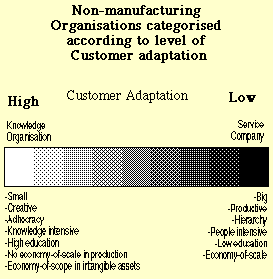
Unauthorised copying prohibited.
NOTE! YOU HAVE REACHED AN OBSOLETE PAGE. FOR THE LATEST INFORMATION PLEASE CONNECT TO MY NEW WEB SITE: www.sveiby.com.au
The Knowledge Organisation belongs to a subgroup within the service sector. The service sector is not a discrete phenomenon but rather a spectrum of company types ranging from those organisations totally adapted to their customers - the knowledge organisations - to organisations that have refined and packaged their output. The latter have more in common with manufacturing companies.

In the companies at the far right, service is industry; the business logic is based on efficient, industrialised pre-programmed production aimed at a mass market. The McDonald's fast-food chain examplifies this type, where even the smile we get as a customer is pre-programmed in the employee's manual.
The companies at the far left, however, are more or less their opposite. The "service" emerges as an ongoing process of problem solving between the customers and teams of experts. They therefore have to treat their customers as individuals. Because the knowledge organisation cannot force its customers to adapt to it, it must perforce adapt to them. Therefore, the rapport or the chemistry between the client and the teams is important.
The "production" of the Knowledge organisations is solving problems that are hard to solve in a standardised manner. The staff (key people) tend to be very competent; highly educated and/or with long experience in a profession often involved with information processing.
The business logic depends on how the managers of the Knowledge Organisations regard their assets, their key people and their customers, how they attract them and how they match their capacity for problem solving with the needs of the customers.
The business logic of the Knowledge Organisation is thus in short:
You may also like to read some background; about how I happened to "discover" the knowledge organisation.
Next Chapter.
Return to Knowledge Management Home Page.